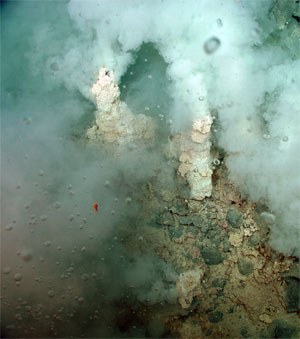 |
| Kim Davies is a PhD student who is studying the feeding ecology of the North Atlantic right whale. (Nick Pearce Photo) |
A Dalhousie student is bringing understanding to the troubling problem of ocean acidification due to increasing atmospheric carbon dioxide.
As an undergraduate, Kim Davies worked with Verena Tunnicliffe, biology professor at the University Victoria, examining how mussels have adapted to extremely acidic waters near underwater volcanoes. The paper she co-authored will be published in the May issue of the journal Nature Geoscience.
“It’s such a euphoric feeling to see that something I did as an undergrad is regarded as important science,” says Ms. Davies, a PhD student at Dalhousie whose research is now focused on the feeding ecology of the North Atlantic right whale. “Wow, it’s so great just to see your name in a high-level journal.”
Carbon dioxide (CO2) emitted to the atmosphere by human activities is being absorbed by the oceans, making them more acidic. Evidence indicates that emissions of carbon dioxide from human activities over the past two centuries have already led to a reduction in the average pH of surface seawater. Because acidification affects the process of calcification, the impact is severe on marine animals like corals, plankton and mollusks which have shells or plates.
So what happens to these animals over time? That’s what the researchers wanted to find out by examining vent mussels (Bathymodiolus brevior) living on the side of submarine volcanoes. The mussels, which have a calcium carbonate skeleton, are under constant stress, bathed by carbon dioxide bubbling out of the ground and from hydro-thermal vents deep beneath the surface.
 |
| Carbon dioxide bubbles out from a underwater volcano. (Photo courtesy of Kim Davies) |
And yet some of the mussels, gathered by remotely operated vehicles along the Mariano volcanic arc near Japan, were determined to be more than 40 years old and had physiologically adapted to living in their extreme environment.
The researchers discovered the mussels grew much slower than mussels in other areas and their shells were very thin. As well, the mussels’ shells were completely covered with protective protein coverings; any breach of that outer layer would quickly destroy the mussel by dissolving the underlying calcium carbonate.
“Their shells—you could see right through them,” says Ms. Davies, who did the lab analysis of samples gathered some 1,500 metres below the surface. “And yet, this species of mussels was able to adapt and build up a tolerance living close to these hydro-thermal vents as long as their protective covering was intact.”
She surmised mussels in other areas would be more vulnerable to ocean acidification because of crabs that scurry over them and wear away at their protective covering. Those predators were absent in the mussel beds near the hydro-thermal vents.
SEE ARTICLE IN NATURE GEOSCIENCE: "Survival of mussels in extremely acidic waters on a submarine volcano"
